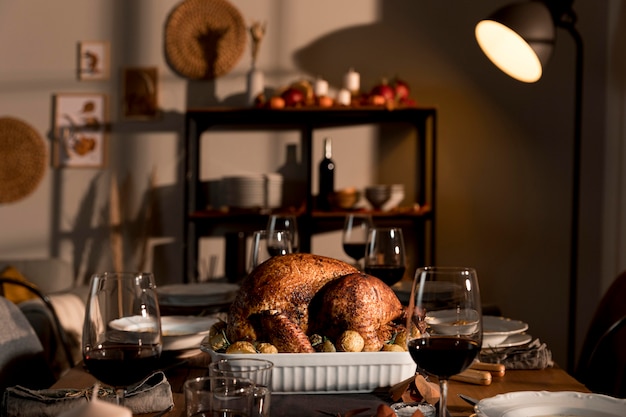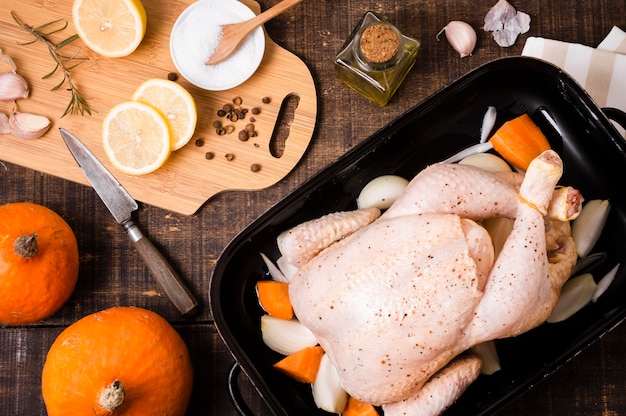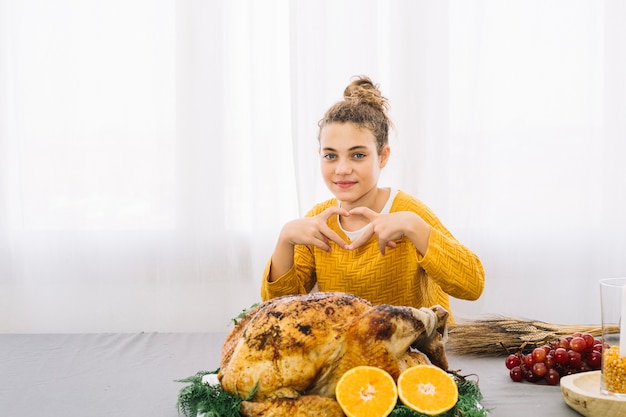Ah, chicken. A kitchen staple, a versatile protein, and a delicious blank canvas for culinary creations. But mastering the art of cooking chicken, especially getting the timing right, is crucial for a satisfying and safe meal. undercooked chicken? No thanks. Overcooked chicken? Dry and disappointing. So, let's embark on a journey to understand chicken cooking times and learn how to cook it to juicy, tender, and delicious perfection.
(Part 1) Safety First: Why Perfect Cooking Time Matters

Before we dive into specific times and techniques, let's talk about the serious stuff – food safety. Raw chicken can harbor nasty little bacteria called Salmonella, which can cause nasty food poisoning. Cooking your chicken to the correct internal temperature is essential for killing off these bacteria and ensuring your meal is safe to enjoy.
The Internal Temperature: The Gold Standard
The golden rule for safe and delicious chicken is to cook it to an internal temperature of 165°F (74°C). Think of this temperature as the magic number that guarantees the chicken is cooked through and safe to eat. Now, you might be thinking, "How do I know if my chicken is at that temperature?" Enter the trusty meat thermometer – your new best friend in the kitchen!
(Part 2) Understanding the Chicken Cuts

Chicken comes in a variety of cuts, each with its own unique cooking time and texture. Let's break down the popular cuts and learn the best ways to cook them.
1. chicken breasts: The Lean and Versatile
Chicken breasts are a kitchen workhorse – lean, relatively quick to cook, and perfect for a variety of dishes. But cooking time can vary depending on the cooking method.
- Pan-frying: Aim for around 4-6 minutes per side, flipping once. You'll know it's done when it's golden brown and no longer pink in the middle.
- Roasting: 20-30 minutes in a preheated oven at 375°F (190°C) is usually enough. A meat thermometer will confirm that the thickest part of the breast reaches 165°F (74°C).
- Grilling: 6-8 minutes per side on a medium-heat grill will create delicious grill marks and a juicy interior.
2. chicken thighs: The Flavorful Champions
Chicken thighs are my personal favorites. They're richer, more flavorful, and retain moisture better than breasts. They're also more robust, so they can handle a bit more heat.
- Roasting: 40-50 minutes in a preheated oven at 375°F (190°C) is generally the right time for bone-in thighs.
- Grilling: 8-10 minutes per side on a medium-heat grill will deliver flavorful results.
- Pan-frying: 10-12 minutes, turning halfway through, is usually sufficient for boneless, skinless thighs.
3. chicken drumsticks: Crispy and Delicious
Chicken drumsticks are a crowd-pleaser, full of flavor and perfect for a casual barbecue or a family roast. They're a bit more substantial, requiring a bit more time to cook than breasts or thighs.
- Roasting: Expect to roast them for about 45-60 minutes in a preheated oven at 375°F (190°C). They're done when they're golden brown and the internal temperature reaches 165°F (74°C).
- Grilling: 15-20 minutes on a medium-heat grill, flipping halfway through for even cooking, will result in a delicious, smoky flavor.
4. chicken wings: Party Stars
Chicken wings, the quintessential party food! They're perfect for saucy marinades and a crispy, golden-brown finish. But they do require a bit more attention when it comes to cooking time.
- Baking: 25-30 minutes in a preheated oven at 400°F (204°C) will result in crispy wings. Toss them in your favorite sauce before baking for an extra layer of flavor.
- Deep-frying: Deep-frying requires a bit more care. Fry your wings in hot oil for 8-10 minutes, until they're golden brown and crispy.
- Grilling: 10-12 minutes on a medium-heat grill, turning every few minutes for even cooking, will give you a delicious, smoky flavor.
5. whole chicken: The Classic Roast
Ah, the whole chicken – the ultimate Sunday roast centerpiece! It takes a bit longer, but it's so worth it. You can roast it with herbs, vegetables, or even a lemon inside for an extra burst of flavor.
- Roasting: 1 hour and 15 minutes to 1 hour and 30 minutes in a preheated oven at 375°F (190°C) is generally the right time for a whole chicken. It's done when the juices run clear when you pierce the thickest part of the thigh.
(Part 3) Factors That Influence Chicken Cooking Time

Now that we've explored the different cuts, let's discuss factors that can affect cooking time, ensuring you get the timing right for your specific dish.
1. The Size of the Chicken
It makes sense that a larger piece of chicken will take longer to cook than a smaller one. So, if you're working with a giant chicken breast or a hefty drumstick, be prepared for a bit more oven time.
2. The Thickness of the Chicken
Similar to size, thickness plays a crucial role in cooking time. A thick chicken breast, for instance, will need a little longer than a thin one. Always check the thickest part with your thermometer to ensure it's reached that magic 165°F (74°C).
3. The Cooking Method
Each cooking method has its own unique timeline. Roasting, grilling, pan-frying, and baking all require different amounts of time for the chicken to cook through. Make sure you're using the correct time estimates for the method you've chosen.
4. The Oven Temperature
Don't underestimate the power of oven temperature. A higher temperature will generally mean a shorter cooking time, while a lower temperature will take a bit longer. Always preheat your oven properly to ensure even cooking.
(Part 4) Tips for perfect chicken Cooking
Now, let's get into some practical tips that will help you cook chicken like a pro, from simple tricks to ensure even cooking to essential tools for success.
1. Don't Overcrowd the Pan
If you're pan-frying or grilling chicken, avoid overcrowding the pan or grill. This will make it harder for the chicken to cook evenly, leading to uneven cooking and potentially steaming instead of browning. Give your chicken enough space to breathe!
2. Pat the Chicken Dry
Before cooking, make sure to pat your chicken dry with paper towels. This will help the skin get crispy and prevent it from steaming instead of browning.
3. Let the Chicken Rest
After cooking, let the chicken rest for 5-10 minutes before carving it. This allows the juices to redistribute, making for a juicier, more flavorful chicken.
4. Use a Meat Thermometer
I know I've said it before, but it's worth repeating: use a meat thermometer! It's the best way to ensure your chicken is cooked to perfection. It's a small investment that will save you from any food poisoning worries.
(Part 5) chicken cooking time chart: Your Ultimate Cheat Sheet
Here's the chicken cooking time cheat sheet you've been waiting for! This table provides approximate times for different cuts and cooking methods. Remember, these are just estimates, so always check the internal temperature with a thermometer.
| Cut | Cooking Method | Time | Internal Temperature |
|---|---|---|---|
| Chicken Breast (Bone-in) | Roasting | 30-40 minutes | 165°F (74°C) |
| Chicken Breast (Boneless, Skinless) | Pan-frying | 4-6 minutes per side | 165°F (74°C) |
| Chicken Thighs (Bone-in) | Roasting | 40-50 minutes | 165°F (74°C) |
| Chicken Thighs (Boneless, Skinless) | Pan-frying | 8-10 minutes per side | 165°F (74°C) |
| Chicken Drumsticks | Roasting | 45-60 minutes | 165°F (74°C) |
| Chicken Wings (Whole) | Baking | 25-30 minutes | 165°F (74°C) |
| Whole Chicken | Roasting | 1 hour 15 minutes to 1 hour 30 minutes | 165°F (74°C) in the thickest part of the thigh |
(Part 6) Avoiding chicken cooking mistakes: A Guide to Success
Let's talk about common mistakes to avoid, ensuring your chicken is cooked to perfection, every time.
1. Overcrowding the Pan: A Recipe for Uneven Cooking
We've already touched on this, but it's worth emphasizing. Overcrowding the pan will prevent the chicken from browning properly and can lead to uneven cooking. Give your chicken enough space to breathe and brown beautifully.
2. Not Checking the Temperature: The Importance of a Meat Thermometer
Don't skip the meat thermometer. It's the only way to be absolutely certain your chicken is cooked through and safe to eat.
3. Overcooking the Chicken: A Dry and Disappointing Outcome
Overcooked chicken is a tragedy! It can be dry and flavorless. Aim for that perfect balance – cooked through but still juicy and tender.
4. Not Letting the Chicken Rest: Maximizing Juiciness
Remember the importance of letting the chicken rest after cooking. It's a small step that makes a big difference in terms of juiciness and flavor.
(Part 7) Exploring the World of chicken recipes: From Classic to Creative
Now that you've mastered the basics of chicken cooking, let's explore the vast world of chicken recipes, from timeless favorites to exciting new creations.
1. The Classic roast chicken: A Timeless Delight
The roast chicken reigns supreme. It's a perfect centerpiece for a family gathering or a special occasion. You can roast it with herbs, vegetables, or even stuff it with a breadcrumb stuffing for extra flavor.
2. The juicy chicken Stir-Fry: Quick, Easy, and Flavorful
For a quick and easy weeknight meal, try a chicken stir-fry. Use any vegetables you like – broccoli, peppers, onions, mushrooms, the list goes on! Just make sure to slice your chicken into bite-sized pieces and cook it quickly over high heat.
3. The Crispy chicken tenders: A Kid-Friendly Favorite
Chicken tenders are a crowd-pleaser, especially with younger eaters. You can bread them and bake them in the oven, or fry them in a pan for a crispy, golden-brown exterior.
4. The Delicious Chicken Curry: Spice Up Your Meal
Chicken curry is a spicy, flavorful dish that's perfect for a cold night. You can use chicken breasts or thighs, and there are endless variations to explore, from mild to fiery.
5. The Refreshing chicken salad: Light and Delicious
Chicken salad is a light and refreshing meal or snack. You can use shredded chicken, mayonnaise, celery, onion, and your favorite seasonings. It's perfect for a picnic or a light lunch.
(Part 8) FAQs: Answers to Your Chicken Cooking Questions
Here are answers to some commonly asked questions about chicken cooking time and techniques.
1. What happens if I undercook chicken?
Undercooked chicken can be dangerous, as it can harbor harmful bacteria like Salmonella that can cause food poisoning. Always cook your chicken to an internal temperature of 165°F (74°C) to ensure it's safe to eat.
2. Can I cook chicken in a microwave?
While it's technically possible, it's not recommended. Microwaving chicken can lead to uneven cooking and potential food safety risks. Stick to conventional methods like roasting, grilling, pan-frying, or baking.
3. What's the best way to tell if chicken is cooked?
The most reliable way to determine if chicken is cooked through is to use a meat thermometer. Insert it into the thickest part of the chicken, avoiding bone, and ensure the temperature reaches 165°F (74°C). If you don't have a thermometer, you can check for doneness by cutting into the chicken. The juices should run clear and the meat should be no longer pink.
4. Can I freeze chicken after cooking it?
Yes, you can freeze cooked chicken. Allow it to cool completely and then store it in an airtight container or freezer-safe bag. Frozen cooked chicken can last for up to 2-3 months in the freezer.
5. Can I reuse marinade on chicken?
It's not recommended to reuse marinade on chicken, especially if the marinade has been in contact with raw chicken. Raw chicken can contain bacteria that can contaminate the marinade. Discard any marinade that has been in contact with raw chicken and use fresh marinade for serving.
There you have it! A comprehensive guide to chicken cooking times, tips, tricks, and even a few recipe ideas to get you started. Now, go forth and conquer the culinary world with your newfound knowledge. Happy cooking!
Everyone is watching

Corn on the Cob: The Ultimate Guide to Perfectly Cooked Ears
Healthy MealsAh, corn on the cob. Just the name evokes images of sunny days, barbecues, and that sweet, juicy flavour that ...

Perfect Pork Roast Oven Cooking Time: A Guide to Delicious Results
Healthy MealsThere's something truly satisfying about a perfectly roasted pork. The aroma alone is enough to make your mout...

Scallops: The Ultimate Guide to Perfect Cooking
Healthy MealsAh, scallops. Those delicate, sweet, and utterly delicious morsels of the sea. They hold a special place in my...

Ham Cooking Time: How Long to Bake, Smoke, or Boil a Delicious Ham
Healthy MealsAh, ham. It's a classic, isn't it? A real crowd-pleaser, especially around holidays. And when done right, it'...

Spaghetti Squash: The Ultimate Guide to Cooking and Serving
Healthy MealsRemember that time you saw spaghetti squash at the supermarket, looking all bumpy and strange, and thought, "W...
